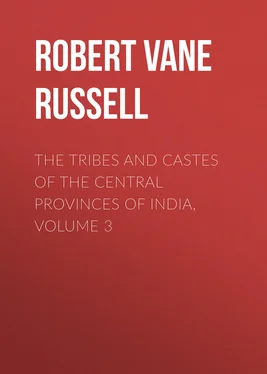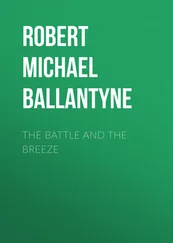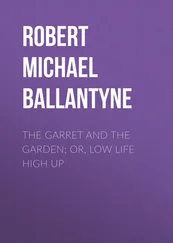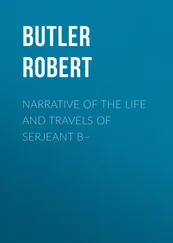Robert Vane Russell - The Tribes and Castes of the Central Provinces of India, Volume 3
Здесь есть возможность читать онлайн «Robert Vane Russell - The Tribes and Castes of the Central Provinces of India, Volume 3» — ознакомительный отрывок электронной книги совершенно бесплатно, а после прочтения отрывка купить полную версию. В некоторых случаях можно слушать аудио, скачать через торрент в формате fb2 и присутствует краткое содержание. Жанр: foreign_prose, История, foreign_edu, foreign_antique, на английском языке. Описание произведения, (предисловие) а так же отзывы посетителей доступны на портале библиотеки ЛибКат.
- Название:The Tribes and Castes of the Central Provinces of India, Volume 3
- Автор:
- Жанр:
- Год:неизвестен
- ISBN:нет данных
- Рейтинг книги:5 / 5. Голосов: 1
-
Избранное:Добавить в избранное
- Отзывы:
-
Ваша оценка:
- 100
- 1
- 2
- 3
- 4
- 5
The Tribes and Castes of the Central Provinces of India, Volume 3: краткое содержание, описание и аннотация
Предлагаем к чтению аннотацию, описание, краткое содержание или предисловие (зависит от того, что написал сам автор книги «The Tribes and Castes of the Central Provinces of India, Volume 3»). Если вы не нашли необходимую информацию о книге — напишите в комментариях, мы постараемся отыскать её.
The Tribes and Castes of the Central Provinces of India, Volume 3 — читать онлайн ознакомительный отрывок
Ниже представлен текст книги, разбитый по страницам. Система сохранения места последней прочитанной страницы, позволяет с удобством читать онлайн бесплатно книгу «The Tribes and Castes of the Central Provinces of India, Volume 3», без необходимости каждый раз заново искать на чём Вы остановились. Поставьте закладку, и сможете в любой момент перейти на страницу, на которой закончили чтение.
Интервал:
Закладка:
The next episode is taken from a slightly different local version:
And while they were cooking their food at the river a great flood came up, but all the Gonds crossed safely except the four gods, Tekām, Markām, Pusām and Telengām. 52 52 Tekām the teak tree, Markām the mango tree, and Telengām the Telugu. These are the names of well-known exogamous septs.
These were delayed because they had cooked their food with ghī which they had looted from the Hindu deities. Then they stood on the bank and cried out,
O God of the crossing,
O Boundary God!
Should you be here,
Come take us across.
Hearing this, the tortoise and crocodile came up to them, and offered to take them across the river. So Markām and Tekām sat on the back of the crocodile and Pusām and Telengām on the back of the tortoise, and before starting the gods made the crocodile and tortoise swear that they would not eat or drown them in the sea. But when they got to the middle of the river the tortoise and crocodile began to sink, with the idea that they would drown the Gonds and feed their young with them. Then the Gonds cried out, and the Raigīdhni or vulture heard them. This bird appears to be the same as the Bindo, as it fed its young with elephants. The Raigīdhni flew to the Gonds and took them up on its back and flew ashore with them. And in its anger it picked out the tongue of the crocodile and crushed the neck of the tortoise. And this is why the crocodile is still tongueless and the tortoise has a broken neck, which is sometimes inside and sometimes outside its shell. Both animals also have the marks of string on their backs where the Gond gods tied their necks together when they were ferried across. Thus all the Gonds were happily reunited and Lingo took them into the forest, and they founded a town there, which grew and prospered. And Lingo divided all the Gonds into clans and made the oldest man a Pardhān or priest and founded the rule of exogamy. He also made the Gond gods, subsequently described, 53 53 See section on Religion.
and worshipped them with offerings of a calf and liquor, and danced before them. He also prescribed the ceremonies of marriage which are still observed, and after all this was done Lingo went to the gods.

Gonds on a journey
(b) Tribal Subdivisions
11. Subcastes
Out of the Gond tribe, which, as it gave its name to a province, may be considered as almost a people, a number of separate castes have naturally developed. Among them are several occupational castes such as the Agarias or iron-workers, the Ojhas or soothsayers, Pardhāns or priests and minstrels, Solāhas or carpenters, and Koilabhutis or dancers or prostitutes. These are principally sprung from the Gonds, though no doubt with an admixture of other low tribes or castes. The Parjas of Bastar, now classed as a separate tribe, appear to represent the oldest Gond settlers, who were subdued by later immigrants of the race; while the Bhatras and Jhādi Telengas are of mixed descent from Gonds and Hindus. Similarly the Gowāri caste of cattle-graziers originated from the alliances of Gond and Ahīr graziers. The Mannewārs and Kolāms are other tribes allied to the Gonds. Many Hindu castes and also non-Aryan tribes living in contact with the Gonds have a large Gond element; of the former class the Ahīrs, Basors, Barhais and Lohārs, and of the latter the Baigas, Bhunjias and Khairwārs are instances.
Among the Gonds proper there are two aristocratic subdivisions, the Rāj-Gonds and Khatolas. According to Forsyth the Rāj-Gonds are in many cases the descendants of alliances between Rājpūt adventurers and Gonds. But the term practically comprises the landholding subdivision of the Gonds, and any proprietor who was willing to pay for the privilege could probably get his family admitted into the Rāj-Gond group. The Rāj-Gonds rank with the Hindu cultivating castes, and Brāhmans will take water from them. They sometimes wear the sacred thread. In the Telugu country the Rāj-Gond is known as Durla or Durlasattam. In some localities Rāj-Gonds will intermarry with ordinary Gonds, but not in others. The Khatola Gonds take their name from the Khatola state in Bundelkhand, which is said to have once been governed by a Gond ruler, but is no longer in existence. In Saugor they rank about equal with the Rāj-Gonds and intermarry with them, but in Chhindwāra it is said that ordinary Gonds despise them and will not marry with them or eat with them on account of their mixed descent from Gonds and Hindus. The ordinary Gonds in most Districts form one endogamous group, and are known as the Dhur or ‘dust’ Gonds, that is the common people. An alternative name conferred on them by the Hindus is Rāwanvansi or of the race of Rāwan, the demon king of Ceylon, who was the opponent of Rāma. The inference from this name is that the Hindus consider the Gonds to have been among the people of southern India who opposed the Aryan expedition to Ceylon, which is preserved in the legend of Rāma; and the name therefore favours the hypothesis that the Gonds came from the south and that their migration northward was sufficiently recent in date to permit of its being still remembered in tradition. There are several other small local subdivisions. The Koya Gonds live on the border of the Telugu country, and their name is apparently a corruption of Koi or Koitūr, which the Gonds call themselves. The Gaita are another Chānda subcaste, the word Gaite or Gaita really meaning a village priest or headman. Gattu or Gotte is said to be a name given to the hill Gonds of Chānda, and is not a real subcaste. The Darwe or Nāik Gonds of Chānda were formerly employed as soldiers, and hence obtained the name of Naīk or leader. Other local groups are being formed such as the Larhia or those of Chhattīsgarh, the Mandlāha of Mandla, the Lānjiha from Lānji and so on. These are probably in course of becoming endogamous. The Gonds of Bastar are divided into two groups, the Māria and the Muria. The Māria are the wilder, and are apparently named after the Mad, as the hilly country of Bastar is called. Mr. Hīra Lāl suggests the derivation of Muria from mur , the palās tree, which is common in the plains of Bastar, or from mur , a root. Both derivations must be considered as conjectural. The Murias are the Gonds who live in the plains and are more civilised than the Mārias. The descendants of the Rāja of Deogarh Bakht Buland, who turned Muhammadan, still profess that religion, but intermarry freely with the Hindu Gonds. The term Bhoi, which literally means a bearer in Telugu, is used as a synonym for the Gonds and also as an honorific title. In Chhindwāra it is said that only a village proprietor is addressed as Bhoi. It appears that the Gonds were used as palanquin-bearers, and considered it an honour to belong to the Kahār or bearer caste, which has a fairly good status. 54 54 See also art. Kahār.
12. Exogamy
The Gond rules of exogamy appear to preserve traces of the system found in Australia, by which the whole tribe is split into two or four main divisions, and every man in one or two of them must marry a woman in the other one or two. This is considered by Sir J. G. Frazer to be the beginning of exogamy, by which marriage was prohibited, first, between brothers and sisters, and then between parents and children, by the arrangement of these main divisions. 55 55 The theory is stated and explained in vol. iv. of Exogamy and Totemism .
Among the Gonds, however, the subdivision into small exogamous septs has been also carried out, and the class system, if the surmise that it once existed be correct, remains only in the form of a survival, prohibiting marriage between agnates, like an ordinary sept. In one part of Bastar all the septs of the Māria Gonds are divided into two great classes. There are ninety septs in A Class and sixty-nine in B Class, though the list may be incomplete. All the septs of A Class say that they are Bhaiband or Dādabhai to each other, that is in the relation of brothers, or cousins being the sons of brothers. No man of Class A can marry a woman of any sept in Class A. The septs of Class A stand in relation of Māmabhai or Akomāma to those of Class B. Māmabhai means a maternal uncle’s son, and Akomāma apparently signifies having the same maternal grandfather. Any man of a sept in Class A can marry any woman of a sept in Class B. It will thus be seen that the smaller septs seem to serve no purpose for regulating marriage, and are no more than family names. The tribe might just as well be divided into two great exogamous clans only. Marriage is prohibited between persons related only through males; but according to the exogamous arrangement there is no other prohibition, and a man could marry any maternal relative. Separate rules, however, prohibit his marriage with certain female relatives, and these will be given subsequently. 56 56 See para. 15.
It is possible that the small septs may serve some purpose which has not been elicited, though the inquiry made by Rai Bahādur Panda Baijnāth was most careful and painstaking.
Интервал:
Закладка:
Похожие книги на «The Tribes and Castes of the Central Provinces of India, Volume 3»
Представляем Вашему вниманию похожие книги на «The Tribes and Castes of the Central Provinces of India, Volume 3» списком для выбора. Мы отобрали схожую по названию и смыслу литературу в надежде предоставить читателям больше вариантов отыскать новые, интересные, ещё непрочитанные произведения.
Обсуждение, отзывы о книге «The Tribes and Castes of the Central Provinces of India, Volume 3» и просто собственные мнения читателей. Оставьте ваши комментарии, напишите, что Вы думаете о произведении, его смысле или главных героях. Укажите что конкретно понравилось, а что нет, и почему Вы так считаете.












